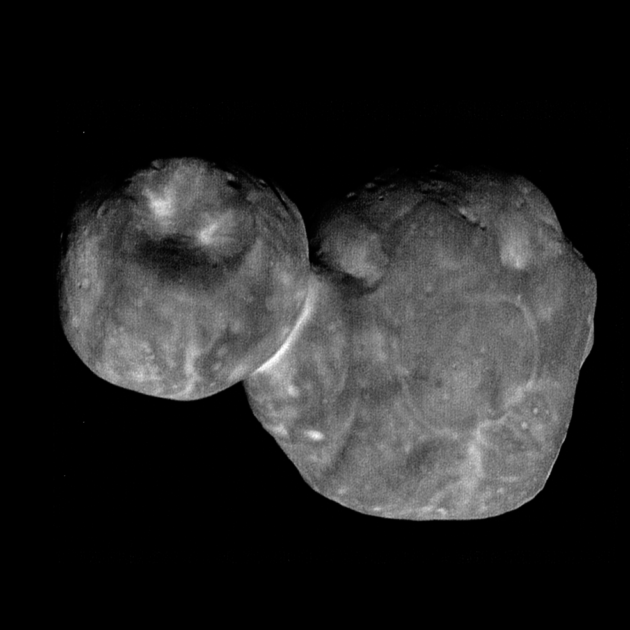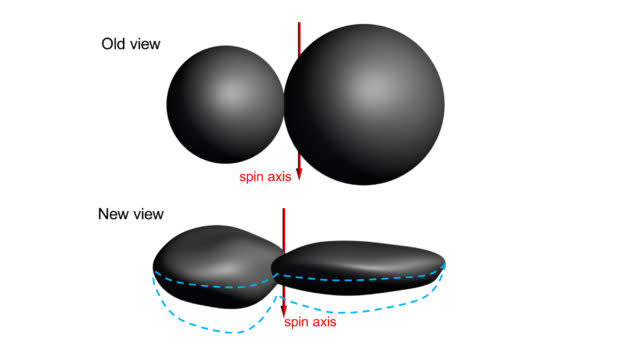Ultimate Ultima: New Horizons team shares sharpest view of space snowman

The scientists behind NASA’s New Horizons spacecraft have released the sharpest possible view of the mission’s latest target, a smooshed-in cosmic snowman known as 2014 MU69 or Ultima Thule.
New Horizons captured gigabytes’ worth of imagery and data as it flew past the icy object, more than 4 billion miles from Earth in the Kuiper Belt, a ring of primordial material on the edge of our solar system. It’s taken weeks to send back detailed data for processing, but now the team says they’ve gotten the best close-up view of Ultima that they’ll ever get.
The best pictures were taken from a distance of 4,109 miles, just six and a half minutes before the time of closest approach at 12:33 a.m. ET Jan. 1 (9:33 p.m. PT Dec. 31). By processing multiple images, the team was able to sharpen image resolution to about 110 feet per pixel.
Principal investigator Alan Stern, a planetary scientist at the Southwest Research Institute, said the imaging campaign hit the “bull’s-eye.”
“Getting these images required us to know precisely where both tiny Ultima and New Horizons were — moment by moment – as they passed one another at over 32,000 miles per hour in the dim light of the Kuiper Belt, a billion miles beyond Pluto,” Stern said today in a news release. “This was a much tougher observation than anything we had attempted in our 2015 Pluto flyby.”
The processing brings out surface details that weren’t readily apparent in earlier images. Among them are several bright, enigmatic, roughly circular patches of terrain. The picture also provides a better look at dark pits near the boundary between Ultima’s sunlit and shadowed sides.
“Whether these features are craters produced by impactors, sublimation pits, collapse pits, or something entirely different, is being debated in our science team,” John Spencer, deputy project scientist from SwRI, said in the news release.
Stern said some of the surface features suggest that Ultima is “unlike any object ever explored before.”
Ultima is thought to represent a contact binary object consisting of material that’s been little changed since the early days of the solar system. From a head-on perspective, Ultima looks like two snowballs that have been stuck together to create a 19-mile-tall snowman (or the BB-8 droid from “Star Wars”). But an analysis of image data captured from the side reveals that the two lobes of the object are actually shaped more like a pancake stuck onto the side of a walnut.
Since the New Year’s encounter, New Horizons has traveled tens of millions of miles beyond Ultima. Mission operations manager Alice Bowman of Johns Hopkins University’s Applied Physics Laboratory reports that the spacecraft is continuing to operate flawlessly.
It’s expected to take another year and a half to send back all the data that New Horizons collected during the flyby, and by that time the mission team may well have selected another target for the probe to survey in the Kuiper Belt.

More from GeekWire:
New Horizons probe sends a sharper view of space snowman … with a bashed-in face
New Horizons team gets first fuzzy glimpse of elongated icy world on solar system’s edge
New Horizons probe delivers 3-D views of cosmic snowman, plus mysteries to solve
NASA’s New Horizons probe reveals the shape of its icy target: ‘It’s a snowman!’
